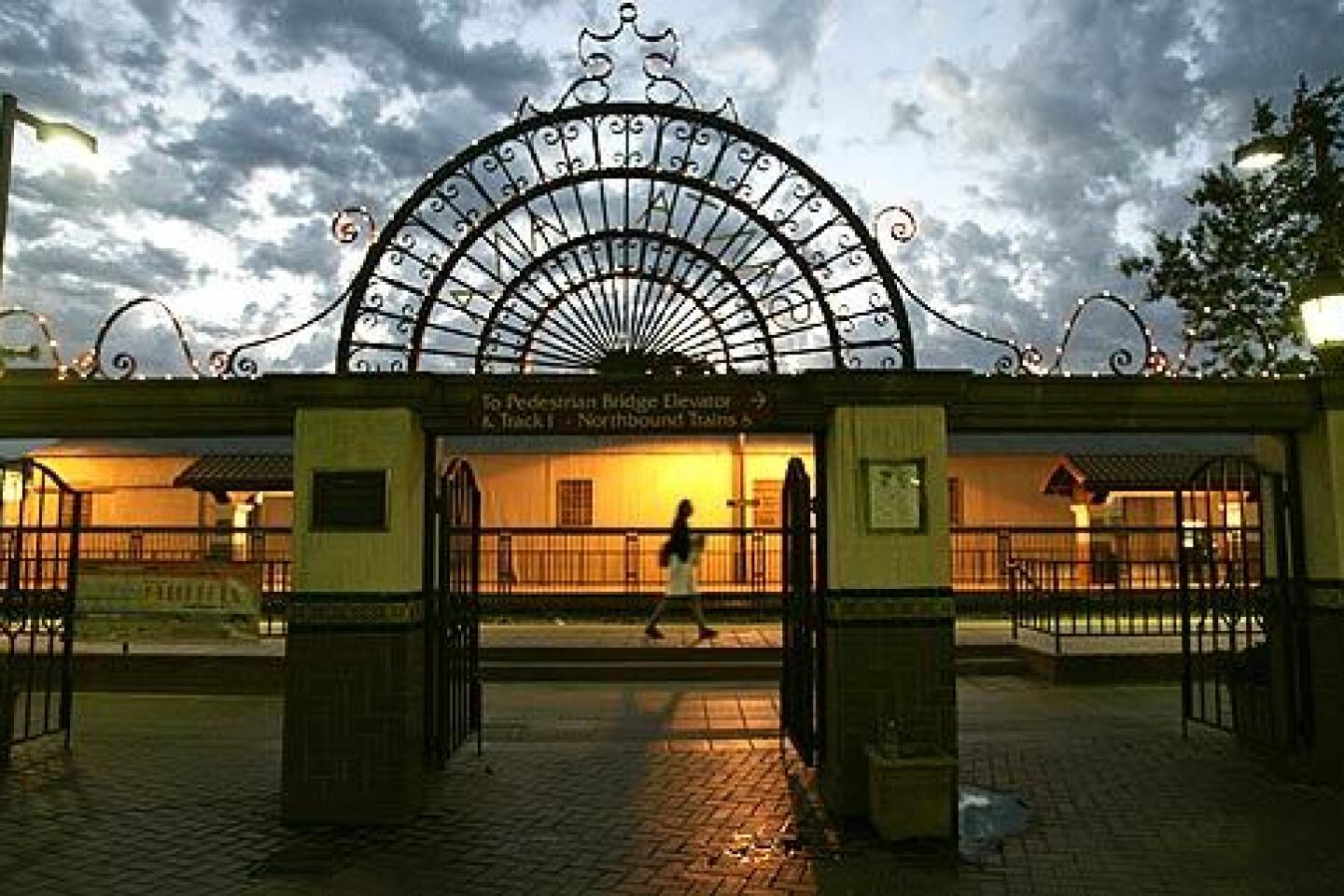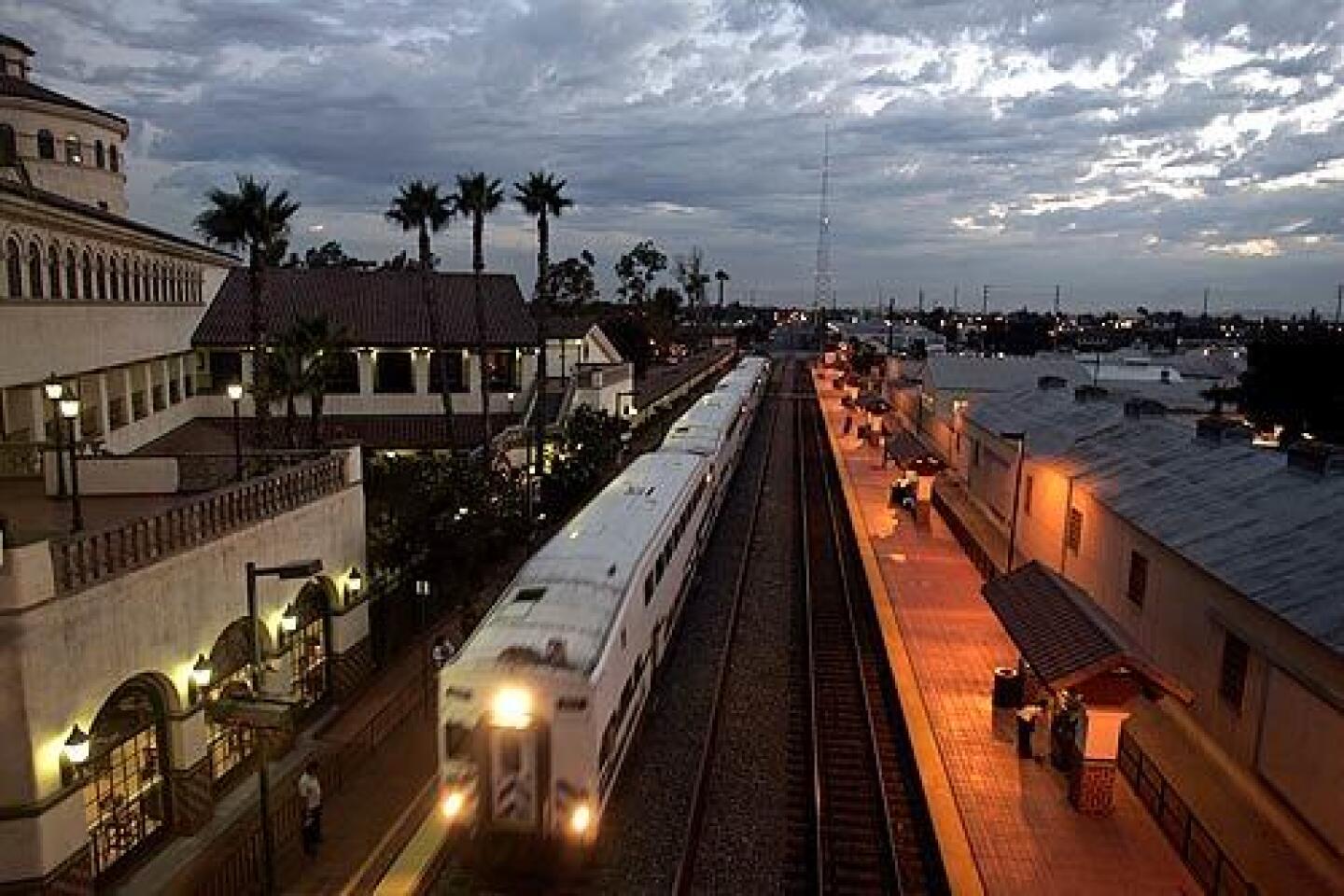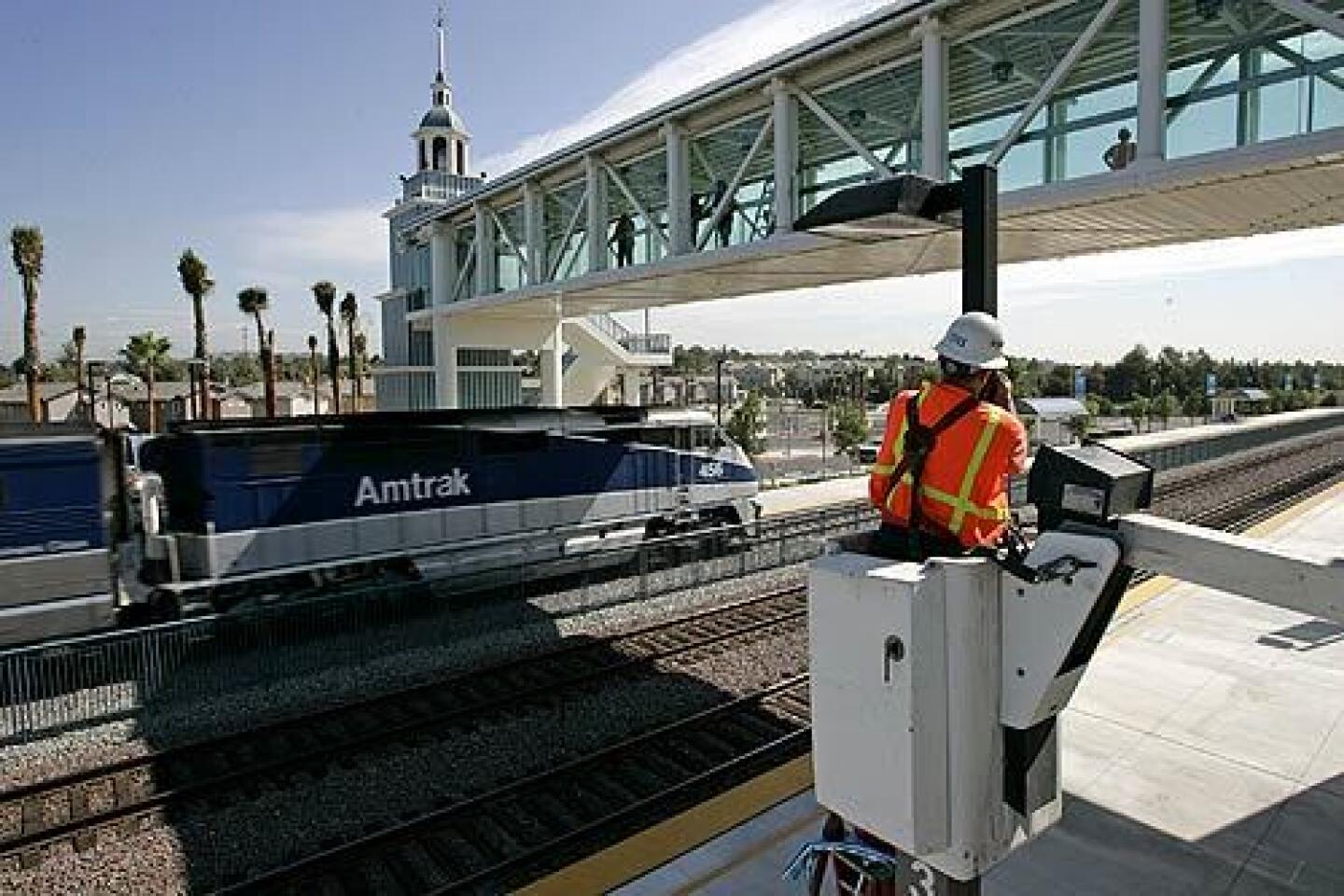Metrolink planners hope better service will lure more riders
- Share via
As the Metrolink train pulled into the Santa Ana station, Martha Hernandez grabbed her purse, carry-all and coffee and boarded the train to Union Station.
At 6:22 a.m. the train will take less than an hour to reach Los Angeles, where she will take a shuttle to USC for graduate classes in social work.
She is a new Metrolink rider. After she left her car at home and triumphed over ticket machines and train schedules, she is now a believer: “It beats driving a car and fighting freeway traffic,” she said.
Hernandez is part of the 8% jump in Metrolink ridership on the Orange County line over last year that Orange County transportation planners hope will continue to grow. With Monday’s approval of $60 million to eliminate the need for trains to blast their horns at most Orange County rail crossings, they are slowly putting the pieces together for expanded Metrolink service.
By 2009, the goal is to have commuter trains running every 30 minutes from 5 a.m. to midnight on weekdays, between Fullerton and Laguna Niguel -- the bookends of Orange County.
Seven locomotives and 59 more passenger cars have been ordered, a new station in Buena Park opens Tuesday, new track has been laid and parking lot improvements are scheduled for Fullerton, Orange, Tustin, Irvine and Laguna Niguel.
For a county that has habitually invested its transportation dollars in freeways and road improvements, the Metrolink expansion marks a new course.
But the value of subsidizing train riders is questioned by some critics, who say rail passengers come from households earning more than $85,000 a year who, unlike traditional bus riders, have the option of driving a car to work.
The recent bus strike highlighted the reliance of the county’s workforce on buses. Many of the county’s 225,000 daily bus riders -- 72% of whom don’t own a vehicle -- walked, biked and carpooled during the 9-day strike.
Bus ridership receives a greater percentage of subsidy in the county than commuter rail, the Orange County Transportation Agency said. Bus riders pay about 25% of the actual cost for transportation compared to more than 50% for Metrolink riders, the agency said.
In addition to higher household income, Metrolink riders average 38 miles each trip. By comparison, half the bus riders earn less than $20,000 a year -- about $45,000 below the county’s median -- and travel only five miles a trip, according to OCTA surveys.
“What that means is that each Metrolink rider is more likely to own a car and has the option of driving that car to work,” said Art Leahy, chief executive of the agency, which operates Metrolink in Southern California with four other agencies. “Every person on a Metrolink train is like the equivalent of taking one car off the Interstate 5.”
With 13,000 daily Metrolink commuters, “it’s not a great percentage,” Leahy conceded. But because that reduction occurs at peak periods, he said they represent roughly one lane of traffic on Interstate 5 at crunch time.
That’s only a marginal benefit, said Genevieve Giuliano, a USC professor and director of the National Center for Metropolitan Transportation Research. She said the claim that each train rider represents a car removed from the freeway is only partly correct because they are considered discretionary riders and can drive to work, and sometimes do so.
Metrolink does provide more overall capacity for the county’s transportation system, she said. “But the question is, should I be subsidizing people who make $85,000 a year or subsidizing those in Santa Ana who earn considerably less?
“For me, I find it hard to defend subsidizing people earning $85,000 when there is only marginal benefit,” she said.
It’s a tough policy question, concedes OCTA board member Art Brown, a prominent rail advocate. Brown, who is a Buena Park councilman, has represented Orange County on Metrolink’s board since 2002.
“When people tell me we shouldn’t be subsidizing Metrolink and other transit, I ask if they use the freeway,” Brown said. “Because having more Metrolink riders means fewer cars for you to contend with on the freeway.”
Hernandez, who lives in Costa Mesa, said she empathizes with those who rely on a bus to get to work. “We had a caregiver for my mother who was always worried about the bus. She was so dependent on buses” because she had no car.
Filiberto Bernal, who lives in Rancho Bernardo and works for Southern California Edison in Commerce, has a 216-mile daily commute.
Asked if Metrolink should continue to subsidize its riders, he responded: “It’s a loaded question because you’re asking somebody who would want to continue to be subsidized as a Metrolink rider.”
Bernal acknowledged that, unlike most bus riders, he owns a car and can drive to work, and does so occasionally.
Metrolink’s purpose, Brown said, “is to get people off the freeways” at peak commute hours. With the expansion, trains will run every 30 minutes in the county, offering consistency and a greater incentive for motorists to use the service, he said.
“We’re also trying to get the fare down so riders will pay slightly more than bus fares when the expansion is finished,” he said.
Freeway projects will remain the transit agency’s main focus. A voter-approved county initiative to raise $12 billion for transportation through 2041 calls for 43% of the tax money to be spent improving freeways, 32% on streets and 25% on public transit, including commuter rail, such as Metrolink, and buses.
High gas prices and a congested Riverside Freeway may have spurred a 14% Metrolink ridership surge from the previous year on the Inland Empire-Orange County Line, transit agency officials said. Passengers on the county’s three Metrolink lines took 3.8 million trips last year.
Overall, Metrolink passengers took 10.5 million trips during the same period in Southern California.
david.reyes@latimes.com
More to Read
Sign up for Essential California
The most important California stories and recommendations in your inbox every morning.
You may occasionally receive promotional content from the Los Angeles Times.

















